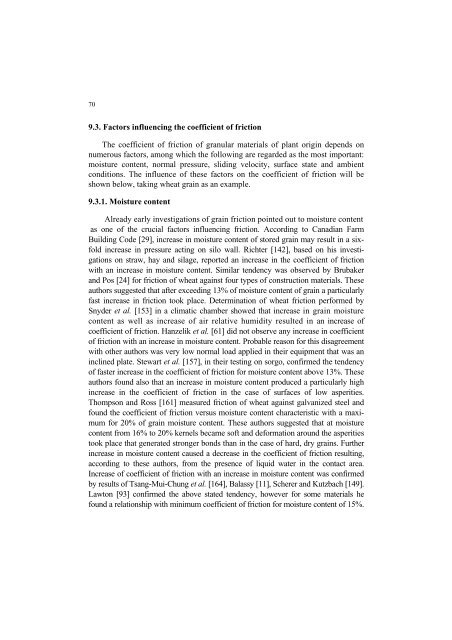Strona 2_redak - Instytut Agrofizyki im. Bohdana DobrzaÅskiego ...
Strona 2_redak - Instytut Agrofizyki im. Bohdana DobrzaÅskiego ...
Strona 2_redak - Instytut Agrofizyki im. Bohdana DobrzaÅskiego ...
Create successful ePaper yourself
Turn your PDF publications into a flip-book with our unique Google optimized e-Paper software.
70<br />
9.3. Factors influencing the coefficient of friction<br />
The coefficient of friction of granular materials of plant origin depends on<br />
numerous factors, among which the following are regarded as the most <strong>im</strong>portant:<br />
moisture content, normal pressure, sliding velocity, surface state and ambient<br />
conditions. The influence of these factors on the coefficient of friction will be<br />
shown below, taking wheat grain as an example.<br />
9.3.1. Moisture content<br />
Already early investigations of grain friction pointed out to moisture content<br />
as one of the crucial factors influencing friction. According to Canadian Farm<br />
Building Code [29], increase in moisture content of stored grain may result in a sixfold<br />
increase in pressure acting on silo wall. Richter [142], based on his investigations<br />
on straw, hay and silage, reported an increase in the coefficient of friction<br />
with an increase in moisture content. S<strong>im</strong>ilar tendency was observed by Brubaker<br />
and Pos [24] for friction of wheat against four types of construction materials. These<br />
authors suggested that after exceeding 13% of moisture content of grain a particularly<br />
fast increase in friction took place. Determination of wheat friction performed by<br />
Snyder et al. [153] in a cl<strong>im</strong>atic chamber showed that increase in grain moisture<br />
content as well as increase of air relative humidity resulted in an increase of<br />
coefficient of friction. Hanzelik et al. [61] did not observe any increase in coefficient<br />
of friction with an increase in moisture content. Probable reason for this disagreement<br />
with other authors was very low normal load applied in their equipment that was an<br />
inclined plate. Stewart et al. [157], in their testing on sorgo, confirmed the tendency<br />
of faster increase in the coefficient of friction for moisture content above 13%. These<br />
authors found also that an increase in moisture content produced a particularly high<br />
increase in the coefficient of friction in the case of surfaces of low asperities.<br />
Thompson and Ross [161] measured friction of wheat against galvanized steel and<br />
found the coefficient of friction versus moisture content characteristic with a max<strong>im</strong>um<br />
for 20% of grain moisture content. These authors suggested that at moisture<br />
content from 16% to 20% kernels became soft and deformation around the asperities<br />
took place that generated stronger bonds than in the case of hard, dry grains. Further<br />
increase in moisture content caused a decrease in the coefficient of friction resulting,<br />
according to these authors, from the presence of liquid water in the contact area.<br />
Increase of coefficient of friction with an increase in moisture content was confirmed<br />
by results of Tsang-Mui-Chung et al. [164], Balassy [11], Scherer and Kutzbach [149].<br />
Lawton [93] confirmed the above stated tendency, however for some materials he<br />
found a relationship with min<strong>im</strong>um coefficient of friction for moisture content of 15%.
















